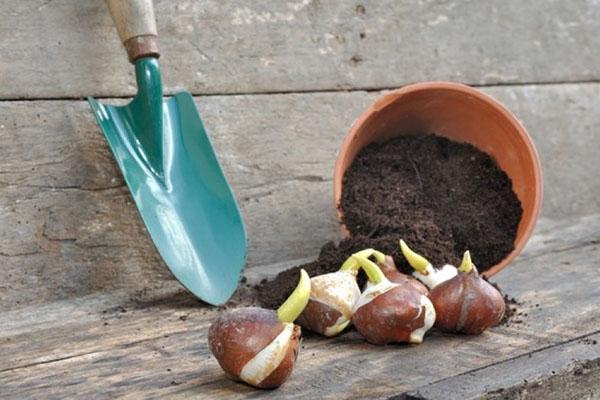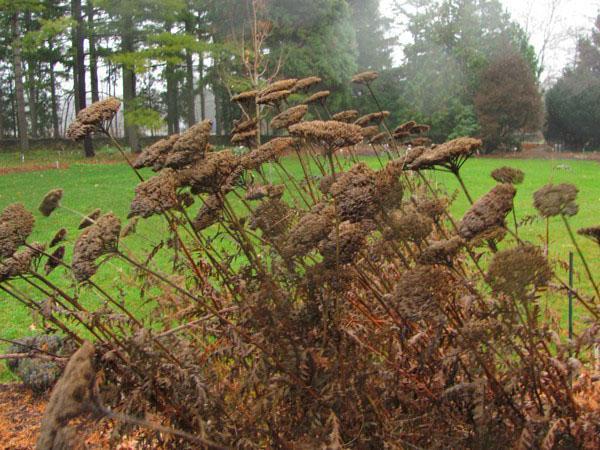Wintering of perennial flowers and preparation rules
 Flowers are called perennial because after the end of the growing season, their root system, and sometimes the aerial part, does not die off. Development only freezes during the winter, so that in the spring the plant wakes up and quickly grows.
Flowers are called perennial because after the end of the growing season, their root system, and sometimes the aerial part, does not die off. Development only freezes during the winter, so that in the spring the plant wakes up and quickly grows.
If in the warm season, decorative perennials require minimal care, then with the arrival of autumn, the florist needs to think about protecting his green pets from the cold. What it will be depends on the climatic characteristics of the region, as well as on the winter hardiness of the crops grown on the site.
Ways to prepare perennials for winter

- crown trimming;
- mulching the soil under the crop;
- insulation of the living above-ground part remaining above the ground.
These events are most often carried out in a complex manner, and non-frost-resistant species and most of the bulbous, except those blooming in early spring, are dug up and stored until spring in warm or cool dry rooms.
Frost-resistant, herbaceous species are enough to cut off, and sprinkle the soil in the flowerbed with suitable mulch. All nutrients, as well as points of future growth in such crops are underground, therefore, after mulching and falling snow cover, the flowers are not threatened.
Features of pre-winter pruning of perennials
 Since the warm season, the aboveground part of the plants is involved in the accumulation of nutrients for the winter, it is better to prune it with the arrival of the first autumn frosts. This period in most regions begins in September and ends closer to the second half of October.
Since the warm season, the aboveground part of the plants is involved in the accumulation of nutrients for the winter, it is better to prune it with the arrival of the first autumn frosts. This period in most regions begins in September and ends closer to the second half of October.
What does pruning perennials give? Removal of dead part:
- excludes the preservation of pest larvae in dry stems;
- reduces the risk of the spread of putrefactive and fungal diseases, including decay of the root system;
- facilitates sheltering and mulching flowers for the winter.
The pruning height depends on the size and structural features of the ornamental plants.
Low-growing small plants are pruned at ground level; in larger specimens with powerful, often semi-lignified shoots, the lower part of the stems is left. On them in the spring it will be possible to accurately determine the location of the plant, and in winter they will additionally retain snow and serve as a natural protection.
 The most frost-resistant, perennial flowers, for example, cornflower, aquilegia, rudbeckia, astilbe and other species, are cut off, leaving no more than 5 cm above the ground from the height of the stems.
The most frost-resistant, perennial flowers, for example, cornflower, aquilegia, rudbeckia, astilbe and other species, are cut off, leaving no more than 5 cm above the ground from the height of the stems.
Delphiniums and similar tall plants with powerful hollow stems are cut, leaving at least 25 cm. Otherwise, water entering the stem easily causes rotting of the upper part of the rhizome and the death of the flower. For plants such as irises, their full-time leaves are cut to a 10-centimeter height a couple of weeks before the onset of cold weather. Curly annual shoots clematis and other similar crops are shortened so that their green parts do not freeze and rot in the shelter over the winter.
How to cover perennial flowers for the winter?
 If the aerial part of the perennial does not die off, or the winter hardiness of the species is in doubt, it is better to play it safe and arrange a shelter for such a flower. Depending on the type and size of the plant, protection is done by:
If the aerial part of the perennial does not die off, or the winter hardiness of the species is in doubt, it is better to play it safe and arrange a shelter for such a flower. Depending on the type and size of the plant, protection is done by:
- from spruce or pine spruce branches;
- a layer of soil or mulch;
- non-woven fabric;
- using boxes filled with shavings or other loose, non-moisture-saturated mulching material;
- other ancillary materials that protect flowers from cold air.
On top, homemade winter houses are covered with waterproof material so that water does not accumulate inside the structures, and during the thaw there is no decay of plants.
 This is done with chrysanthemums, not winter-hardy varieties. roses, climbing flowering plants, which are previously removed from the trellises and tilted to the ground sprinkled with mulch. Perennial flowers overwintering on alpine slides can be covered not one by one, but together. A dense non-woven fabric is well suited for this. In order for the protection to be truly high-quality, the edges of the canvas are sprinkled with soil so that it does not shift.
This is done with chrysanthemums, not winter-hardy varieties. roses, climbing flowering plants, which are previously removed from the trellises and tilted to the ground sprinkled with mulch. Perennial flowers overwintering on alpine slides can be covered not one by one, but together. A dense non-woven fabric is well suited for this. In order for the protection to be truly high-quality, the edges of the canvas are sprinkled with soil so that it does not shift.
Straw and fallen leaves can attract harmful insects and rodents, preserve and spread fungal and bacterial infections dangerous for plants. In addition, the leaves cake during the winter and contribute to the development of decay. Therefore, it is better to refuse such materials for mulching. Experienced flower growers advise using needles, sawdust, soil mixed with humus, dried shavings as mulch.
The most unadapted species to frosty winter need to be dug up and stored in conditions suitable for a particular culture. Primroses are left in the ground, but they must be mulched thickly and in winter they are additionally sprinkled with snow.
The thickness of the snow cover in flower beds with perennials should be at least 50–80 cm. Snow caking and the formation of a dense continuous crust must not be omitted, otherwise the plants will simply wither by the spring.